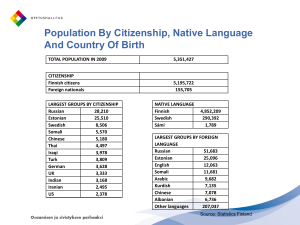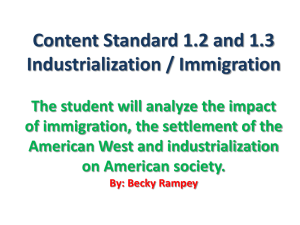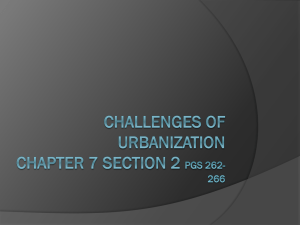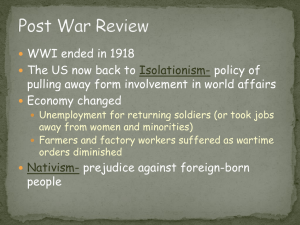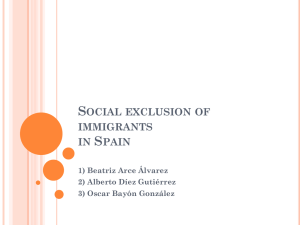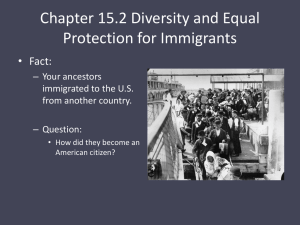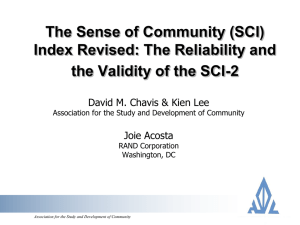Access for All - Florida Library Association
advertisement
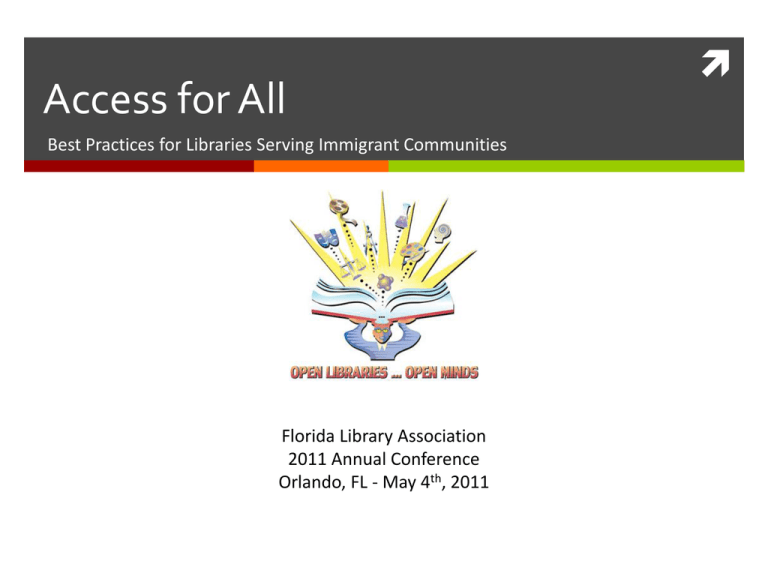
Access for All Best Practices for Libraries Serving Immigrant Communities Florida Library Association 2011 Annual Conference Orlando, FL - May 4th, 2011 Panel Lucía M. González. President REFORMA (The National Association to Promote Library and Information Services to Latinos and the Spanish Speaking) Adam S. Davis. Branch Manager. West Boynton Branch Library (Palm Beach County Library System) Isabel Castro. MLIS Graduate Student San Jose State University Alicia K. Long. MLIS Graduate Student. Spectrum Scholar University of South Florida – School of Information Serving Immigrants Introduction: Who are Florida’s Immigrants? Access to Services Collection Development Programming Multicultural Communities All people live in an increasingly heterogeneous society. There are more than 6,000 different languages in the world. The international migration rate is growing every year resulting in an increasing number of people with complex identities. Globalization, increased migration, faster communication, ease of transportation and other 21st century forces have increased cultural diversity in many nations where it might not have previously existed or has augmented the existing multicultural makeup. - IFLA Multicultural Library Manifesto, 2009 Multicultural Communities: Guidelines for Library Services. Third Edition. International Federation of Library Associations and Institutions. P.O. Box 95312, 2509 CH, The Hague, Netherlands. Tel: +31-70-3140-884; Fax: +31-70-3834-827; e-mail: IFLA@ifla.org; Web site: http://www.ifla.org, 2009. Print. What is an immigrant? The Nation’s Immigrants States with 18.7% or more foreign-born population Source: U.S. Census Bureau 2005-2009 American Community Survey 5-Year Estimates. Florida’s Immigrants Florida’s Population Total: 15,058,521 Foreign-Born by Region Caribbean: 1,383,555 South America: 599,447 Other: 514,094 Foreign-Born: 3,479,448 7% 81% 19% 3% 3% 2% 2% 2% 0% Central America: 343,317 South and East Asia: 297,750 Mexico: 275,428 Middle East: 65,857 Source: Pew Hispanic Center tabulations of 2009 American Community Survey (1% IPUMS) Florida’s languages Population speaking language other than English at home: 4,412,787 people (population 5 years of age and older) Languages Spoken: Spanish: Other Indo-European Languages: Asian and Pacific Islander: Other Languages: 3,221,199 870,129 230,892 90,567 Source: U.S. Census Bureau. 2005-2009 American Community Survey. Spanish Speakers French Creole Speakers Number of speakers per language in Florida Diversity in diversity Differentiate: Immigrants / Foreign-born / English Language Learners (ELL) / Hispanics-Latino / Asian / ... Recognize: Immigrants; First, second or third- generation Americans. Be specific: Spanish-speaking: Cubans, Puerto Ricans, Hondurans, Colombians, etc.... and families with members of different nationalities. Get to know your community! Access for All: Why? ALA Key Action Areas. Diversity. “Diversity is a fundamental value of the association and its members, and is reflected in its commitment to recruiting people of color and people with disabilities to the profession and to the promotion and development of library collections and services for all people” ALA Policy Manual. Section 60: Diversity. Resolution in support of immigrants' rights to free public library access. (ALA – REFORMA, 2005) “RESOLVED, that the American Library Association work with REFORMA and other affiliates to develop a public information strategy to inform and educate public libraries and member constituents about alternate forms of identification that will allow free public access to library services for ALL immigrant populations.” Access for All: How to Build your Case Demographics (based on language, country of origin) RUSA RSS Guidelines for Library Services to Spanish- Speaking Library Users RUSA RSS Guidelines for the Development and Promotion of Multilingual Collections and Services Library Bill of Rights / Declaracion de los Derechos de las Bibliotecas Freedom to Read Access to Library Services Partnerships Organizations to seek out as likely partners: • Government agencies • Community-based organizations • Immigrant organizations • Adult education providers • Local universities and community colleges • Faith-based organizations • Local public school systems • Social services agencies • Refugee and resettlement organizations • Local business associations and service clubs Library Services for Immigrants: A Report on Current Practices. Washington, D.C.: Office of Citizenship, U.S. Citizenship and Immigration Services, 2006. Internet resource The staff of The American Place, an immigration program at the Hartford Public Library in Connecticut, took advantage of the proximity of their library to government offices and developed a close working relationship with the local USCIS Hartford Field Office. Library staff members regularly participate in community meetings hosted by the Hartford Field Office to provide input on local immigration matters. The Queens Borough Public Library in New York has a partnership with the Queens Health Network, the largest healthcare provider in the area. They work together to plan monthly “coping skills” workshops addressing the health needs of immigrants and featuring speakers from two local public hospitals. The King County Library System in the state of Washington joined forces with a local literacy organization, a church, and the USCIS Seattle District Office to develop a pilot program called “Centered on Citizenship.” The program’s goal is to involve teen tutors in preparing adult and elderly citizenship applicants for the naturalization process. Tutoring includes question-andanswer practice for the naturalization test as well as English language dictation practice. In addition, applicants get training and practice in techniques to help them handle the stress that may arise during their naturalization interview. Library Services for Immigrants: A Report on Current Practices. Washington, D.C.: Office of Citizenship, U.S. Citizenship and Immigration Services, 2006. Internet resource. Access to Library Services Outreach Strategies for helping immigrant patrons feel welcome and valued in the library: • Serve on the library board. • Library tours • Roundtable discussions • Participate in local public events to publicize the library’s services for immigrants • Print a brief brochure or flyer • Develop public service announcements (PSAs) for local radio stations. Library Services for Immigrants: A Report on Current Practices. Washington, D.C.: Office of Citizenship, U.S. Citizenship and Immigration Services, 2006. Internet resource The Outreach Librarian at the Boulder Public Library considers outreach to be inextricably linked to partnerships. Her first step as an Outreach Librarian was to attend meetings held by community groups and other organizations. In collaboration with other agencies, the library was able to initiate an Immigration and U.S. Citizenship Advocacy Group consisting of representatives of local government agencies, schools, adult education and literacy programs, and other organizations. The Queens Borough Public Library distributes “Help!” booklets and bookmarks to assist immigrant library patrons. Available in English and 12 other languages, the “Help!” materials feature basic library terminology. “Library Links!,” the multilingual outreach program of the Minneapolis Public Library in Minnesota, has six Bilingual Outreach Liaisons. These library staff members develop partnerships, attend community events, make regular contact with other organizations to inform them about library programs and events, and help introduce immigrants to the library. Bilingual Outreach Liaisons also work regular shifts at the library so that patrons will know when bilingual assistance is available. In addition, they also translate all appropriate library-produced literature and provide training workshops for teachers who work with immigrants. Library Services for Immigrants: A Report on Current Practices. Washington, D.C.: Office of Citizenship, U.S. Citizenship and Immigration Services, 2006. Internet resource. Barriers to Access What a library means to the patron depends on the country of origin Staffing Physical access to collections and services Library policies Library cards Access to Library Cards An Example of Alternate ID: Mexico’s “Matrícula Consular” Matrícula Consular includes local address. Issuance Requirements 1.Proof of Nationality 2.Proof of Identity 3.Proof of Establishment 4.Issuance Fee Payment Collection Development Why do we need materials in languages other than English? Isabel Castro Librarians for Tomorrow San Jose State University 10 Reasons Why We Buy (Insert foreign language here) Materials Adapted from “10 reasons Why We Buy Spanish Books” by Al Milo, retrieved from REFORMA’s website (resources and publications.) 1. It is part of our library's written mission statement to serve the needs of a "culturally diverse community.” 2. It is part of our library's collection development plan to purchase non-English materials whenever a group in the community reaches 5% or more of the pop. According to the Census, the Hispanic pop. of Fullerton is 21%. 3. Spanish-speakers are "taxpayers" too and contribute to the economic well being of the community. They pay sales, property and utility taxes like everyone else! 4. Not all important literary works ever written have been written only in English. There are authors like Pablo Neruda, Octavio Paz, Isabel Allende, Gabriel Garcia Marquez, Laura Esquivel and Cervantes, who all wrote original works in Spanish. Neruda even received the Nobel Prize for Literature for his efforts! 5. The Spanish-speaking have rights to information just like everyone else, particularly in areas of health (e.g. AIDS), law (e.g. how to become a citizen), and parenting (e.g. how to support the family unit). Their reading interests are as wide and varied as those of English speakers. 6. There is a strong correlation between literacy in one language and literacy in a second language. Just by being in the library, a Spanish speaker gets exposed to the wealth of material available in the English language. When I have done ESL tours I point out our pictures books and even the juvenile collection as starting points for learning basic English. 7. The library is helping to provide opportunities for recent immigrants to learn English. We have ESL tapes, bilingual dictionaries and literacy classes. How else are they going to learn! People don't learn English just because you pass a law. They need to be provided with opportunities to learn English. 8. The majority of Spanish speakers that I have met in the library agree that in order to function in the United States that they need to learn English. Most of them are "thirsting" for the ability to speak in English. Just look at the many names on waiting lists for ESL classes. Like many immigrants before them, however, it takes time. Usually by the 3rd generation they, like others before them, become monolingual English speakers. It was true of the Germans, the Irish, and other groups. UPDATE: 14% of second-generation Hispanics report that they speak only English, while a mere 6% are Spanish-only speakers. 80% of second-generation Hispanics are bilingual, with 92% of them speaking English well or very well, and half of them indicating that they are actually English-dominant (Pew 2004a, 2004b; Alba 2004). 9. Traditionally, public libraries have always had non-English collections. Look at the large city libraries of NYPL, LAPL and Chicago PL. In California one of the main differences is that now the emphasis is on Pacific Rim languages and not European languages. Why weren't there complaints 10 years ago when Fullerton's collection was predominantly Italian, German, and French books? 10. Finally, the proportion of Spanish books purchased is still dwarfed by the proportion of English books in the collection. Fullerton has 3,000 Spanish books out of 250,000 books total. This translates into only 1% of the collection! If anything, we should be buying more Spanish books not less. Programming Multicultural Programming: Sharing Similarities and Differences Lucía M. González Formula for success Program responsibly to serve the real needs of the families and children in the community while promoting mutual knowledge, respect, and appreciation. First Voice Programming Write a grant so you can bring performers, authors, and renowned special guests Include music, dancing, puppetry, and treats in the story hour Work with artists and personalities in the community Celebrate significant cultural events such as the independence day of the countries of origin of the majority of the groups in your community, Three King’s Day, Dia de los niños, NOCHE DE CUENTOS, etc. Recommendations Library programming must first and foremost respond to the needs of customers and potential customers. Take the time to introduce the myriad resources available at the library, so that they can find a job, read about what is happening in their home country, and find a good book. As part of the program, introduce audience to related library resources and information on how to use the library in their own language. A performance by a local folkdance group would be followed by a brief discussion of the books, web links and other resources available on the particular dance tradition, the country and other art forms. Always have bilingual handouts that include information on how to sign up for a library card Offer Wide Selection Family Literacy Community/public services informative programs Vocational Programs English language instruction Computer classes (in their language, or bilingual) Recommended! Queens Library Newcomers Programswww.queenslibrary.org/index.aspx?page_nm=NAP++Programs Coping Skills: Free lectures and workshops in the most widely spoken immigrant languages of Queens on topics essential to new immigrants' acculturation, such as citizenship and job training information, advice on helping children learn, and information on available social services. Cultural Programs: Free readings, concerts and workshops celebrating the literary, performing and folk arts of immigrants from Asia, Africa, Europe, Latin America, and the Caribbean. Recommended! Broward County Library’s Newcomers/New Americans Program www.bplfoundation.org/newcomers.htm Designed to assist residents from other countries, whose primary language is not English, or who are not English proficient, to successfully maneuver life and living in America, offering courses to develop employability skills, computer skills, citizenship orientation, parenting, home buying, cultural programs and young adult forums in Spanish, Haitian Creole and Portuguese.A Multiethnic Resource Online Directory was produced with funding from this program that includes civic and political organizations, cultural groups, educational organizations, gay and lesbian organizations, media organization and religious organizations. It also includes a listing of festivals and other cultural celebrations. Family Literacy – Noche STORYTELLING NEVER FAILS http://accessforall.wikispaces.com Thank You / Gracias / Obrigado / Di ou mèsi / Salamat / Danke / Merci / شكرا/ शक्रु िया / 谢谢 / Grazie / 감사합니다 / ...
